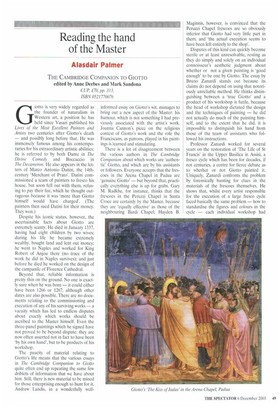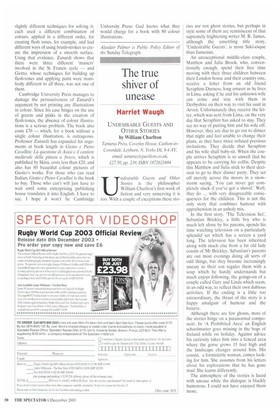Reading the hand of the Master
Alasdair Palmer
THE CAMBRIDGE COMPANION TO GIOTTO edited by Anne Derbes and Mark Sandona CUP, .00, pp. 313. ISBN 0521770076 Giotto is very widely regarded as the founder of naturalism in Western art, a position he has held since Vasari published his Lives of the Most Excellent Painters and Artists two centuries after Giotto's death — and possibly long before that. He was immensely famous among his contemporaries for his extraordinary artistic abilities: he is referred to by both Dante in The Divine Comedy and Boccaccio in The Decameron. He also appears in the letters of Marco Antonio Datini, the 14thcentury 'Merchant of Prato'. Datini commissioned a team of painters to fresco his house, but soon fell out with them, refusing to pay their fee, which he thought outrageous because it was 'more than Giotto himself would have charged'. (The painters then sued Datini for their money. They won.)
Despite his iconic status, however, the ascertainable facts about Giotto are extremely scanty. He died in January 1337, having had eight children by two wives; during his life he became extremely wealthy, bought land and lent out money; he went to Naples and worked for King Robert of Anjou there (no trace of the work he did in Naples survives); and just before he died he worked on the design of the campanile of Florence Cathedral.
Beyond that, reliable information is pretty thin on the ground. No one is exactly sure when he was born — it could either have been 1266 or 1267, although other dates are also possible. There are no documents relating to the commissioning and execution of any of his surviving works — a vacuity which has led to endless disputes about exactly which works should be ascribed to the Master himself. Even the three-panel paintings which he signed have not proved to be beyond dispute: they are now often asserted not in fact to have been 'by his own hand', but to be products of his workshop.
The paucity of material relating to Giotto's life means that the various essays in The Cambridge Companion to Giotto quite often end up repeating the same few driblets of information that we have about him. Still, there is new material to be mined for those enterprising enough to hunt for it. Andrew Landis, in a wonderfully well
informed essay on Giotto's wit, manages to bring out a new aspect of the Master: his humour, which is not something I had previously associated with the artist's work. Joanna Cannon's piece on the religious context of Giotto's work and the role the Franciscans, as patrons, played in his paintings is learned and stimulating.
There is a lot of disagreement between the various authors in The Cambridge Companion about which works are 'authentic' Giotto, and which are by his assistants or followers. Everyone accepts that the frescoes in the Arena Chapel in Padua are 'genuine Giotto' — but beyond that, practically everything else is up for grabs. Gary M. Radkhe, for instance, thinks that the frescoes in the Peruzzi Chapel in Santa Croce are certainly by the Master, because they are 'equally effective' as those of the neighbouring Bardi Chapel; Hayden B. Maginnis, however, is convinced that the Peruzzi Chapel frescoes are so obviously inferior that Giotto had very little part in them, and 'the actual execution seems to have been left entirely to the shop'.
Disputes of this kind can quickly become sterile or at least unresolvable, resting as they do simply and solely on an individual connoisseur's aesthetic judgment about whether or not a given painting is 'good enough' to be one by Giotto. The essay by Bruno Zanardi stands out because its claims do not depend on using that notoriously unreliable method. He thinks distinguishing between a 'true Giotto' and a product of his workshop is futile, because the head of workshop dictated the design and the techniques of painting — he did not actually do much of the painting himself, and to the extent that he did, it is impossible to distinguish his hand from those of the team of assistants who followed his instructions.
Professor Zanardi worked for several years on the restoration of 'The Life of St Francis' in the Upper Basilica in Assisi, a fresco cycle which has been for decades, if not centuries, a centre for fierce debate as to whether or not Giotto painted it. Uniquely, Zanardi confronts the problem by forensically hunting for clues in the materials of the frescoes themselves, He shows that, whilst every artist responsible for the execution of a large fresco cycle faced basically the same problem — how to standardise the figures and colours in the cycle — each individual workshop had slightly different techniques for solving it: each used a different combination of colours, applied in a different order, for creating flesh tones, for example, and had different ways of using brush-strokes to create the impression of a smooth surface. Using that evidence, Zanardi shows that there were three different 'masters' involved in the St Francis cycle — and Giotto. whose techniques for building up flesh-tones and applying paint were manifestly different to all three, was not one of them.
Cambridge University Press manages to damage the persuasiveness of Zanardi's argument by not printing any illustrations in colour. Since his case hinges on the use of greens and pinks in the creation of flesh-tones, the absence of colour illustrations is a serious problem. The book also costs £70 — which, for a book without a single colour illustration, is outrageous. Professor Zanardi has expanded his arguments at book length in Giotto e Pietro Cavallini: La questione di Assisi e ii cantiere medievale della pittura a fresco, which is published by Skira, costs less than £20, and also has 80 beautiful colour pictures of Giotto's works. For those who can read Italian, Giotto e Pietro CavaRini is the book to buy. Those who can't will just have to wait until some enterprising publishing house translates it into English. I have to say, I hope it won't be Cambridge University Press: God knows what they would charge for a hook with 80 colour illustrations.
Alasdair Palmer is Public Policy Editor of the Sunday Telegraph.



























































































 Previous page
Previous page